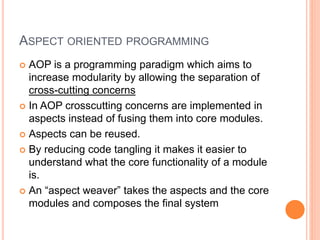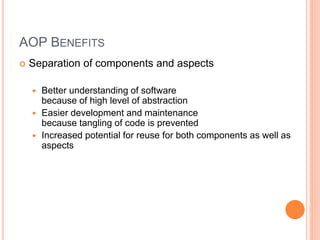Performance analysis of synchronisation problem
- 1. PERFORMANCE ANALYSIS OF SYNCHRONISATION PROBLEM USING ASPECT ORIENTED PROGRAMMING Submitted by:- Harshit monish 9911103466 F-4
- 2. OVERVIEW Cross Cutting Concerns Logging Producer Consumer problem(synchronization) The cost of tangled code Aspect Oriented Programming Development stage Terminology Aop benefits and oop shortcomings Producer Consumer problem
- 3. CROSS CUTTING CONCERNS:- What is a crosscutting concern? Behavior that cuts across the typical divisions of responsibility, such as logging or debugging A problem which a program tries to solve. Aspects of a program that do not relate to the core concerns directly, but which proper program execution nevertheless requires
- 5. CROSS CUTTING CONCERNS:- Examples Synchronisation Logging Authorisation Exception handling
- 9. TWO PROBLEMS AOP TRIES TO SOLVE
- 10. TWO PROBLEMS AOP TRIES TO SOLVE
- 11. THE COST OF TANGLED CODE redundant code same fragment of code in many places difficult to reason about non-explicit structure the big picture of the tangling isn’t clear difficult to change have to find all the code involved and be sure to change it consistently Poor traceability Lower productivity Less code reuse Harder refactoring
- 12. ASPECT ORIENTED PROGRAMMING AOP is a programming paradigm which aims to increase modularity by allowing the separation of cross-cutting concerns In AOP crosscutting concerns are implemented in aspects instead of fusing them into core modules. Aspects can be reused. By reducing code tangling it makes it easier to understand what the core functionality of a module is. An “aspect weaver” takes the aspects and the core modules and composes the final system
- 14. AOP DEVELOPMENT STAGES Integrating all concerns Identify concerns
- 15. What’s in it for YOU?
- 16. BENEFITS Write less code Read less code More concise and easy to understand More maintainable Fewer code = Less boilerplate code More interesting work Increased attention More PRODUCTIVITY! FEWER DEFECTS!
- 17. TERMINOLOGY Cross-cutting – Identify areas of code where common functionality exists Advice – The code to be injected Joinpoint – Where one or more aspects can be applied Pointcut – A collection of joinpoints Aspect – General term for where advice and point-cuts are combined
- 18. TERMINOLOGY Weaving – Integrating applications and aspects (e.g. AspectJ is an “aspect weaver”) Compile-time – Can produce integrated source- code, but typically only produces woven byte- code. Run-time – Aspects are applied “on the fly” (typically when classes are loaded)
- 19. OOP SHORTCOMINGS OOP allows to decompose a system into units of function or behavior Certain software properties cannot be isolated in single functional unit, instead they crosscut multiple components Such crosscutting concerns result in tangled code that is hard to develop and maintain
- 20. AOP BENEFITS Separation of components and aspects Better understanding of software because of high level of abstraction Easier development and maintenance because tangling of code is prevented Increased potential for reuse for both components as well as aspects
- 21. AOP breaks encapsulation in a controlled manner. Encapsulation is broken between classes and aspects. Aspects marked as privileged have access to the private members of a class. Encapsulation is preserved between classes. An aspect encapsulates a crosscutting concern. WHAT ABOUT ENCAPSULATION?
- 22. PROBLEM DESCRIPTION Question: ''How to enforce synchronization policies with AOP?'' Suppose multiple objects are concurrently working on some shared data and exclusive access is needed for modification All objects that are working on the data must be synchronized, for example by locking the shared data temporarily
- 23. PROBLEM DESCRIPTION Question: ''How to enforce synchronization policies with AOP?'' Suppose multiple objects are concurrently working on some shared data and exclusive access is needed for modification All objects that are working on the data must be synchronized, for example by locking the shared data temporarily
- 24. OBSERVATION Without AOP Every component that works on the shared data must take care of the locking itself, leading to tangled and complex code With AOP The locking aspect is separated from the components by means of an aspect module, resulting in usual benefits of modularization
- 25. THE PRODUCER CONSUMER ASPECT

























